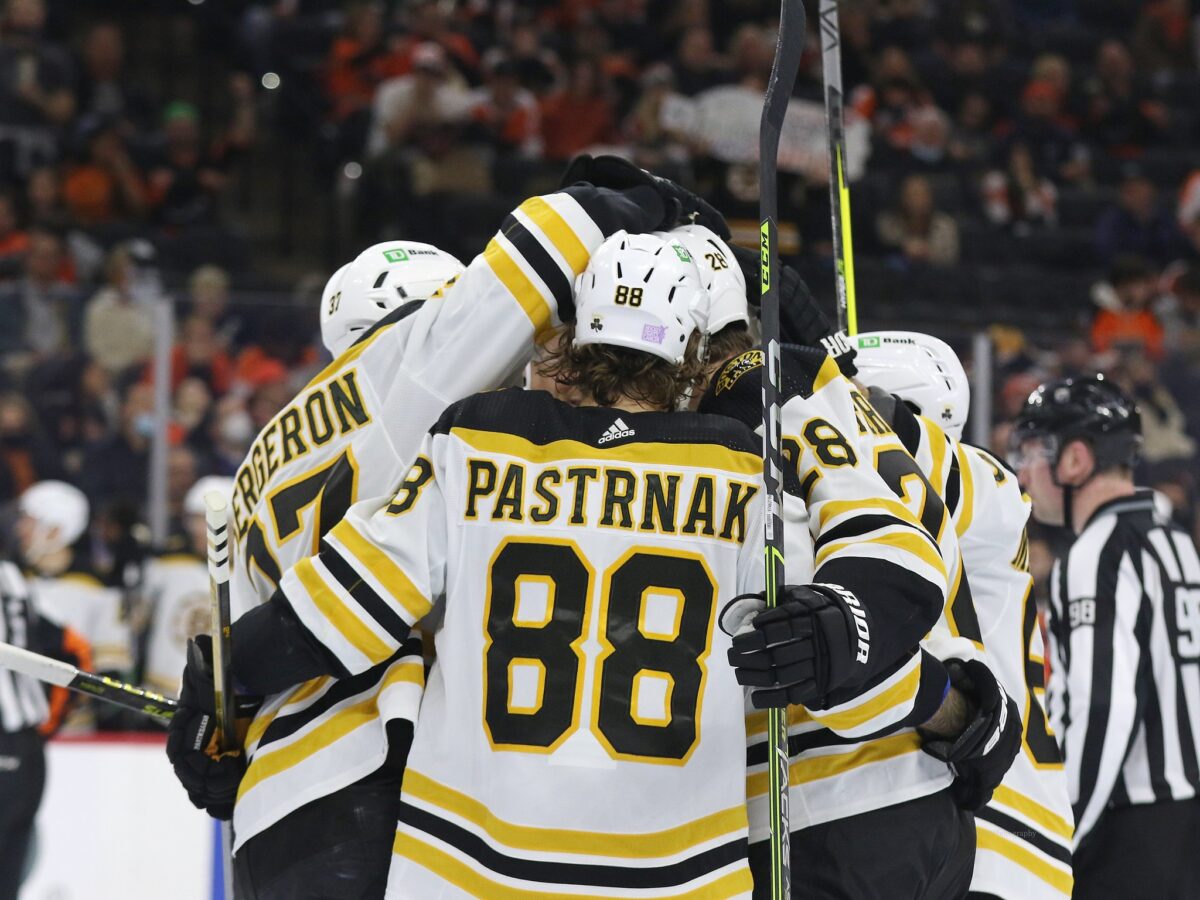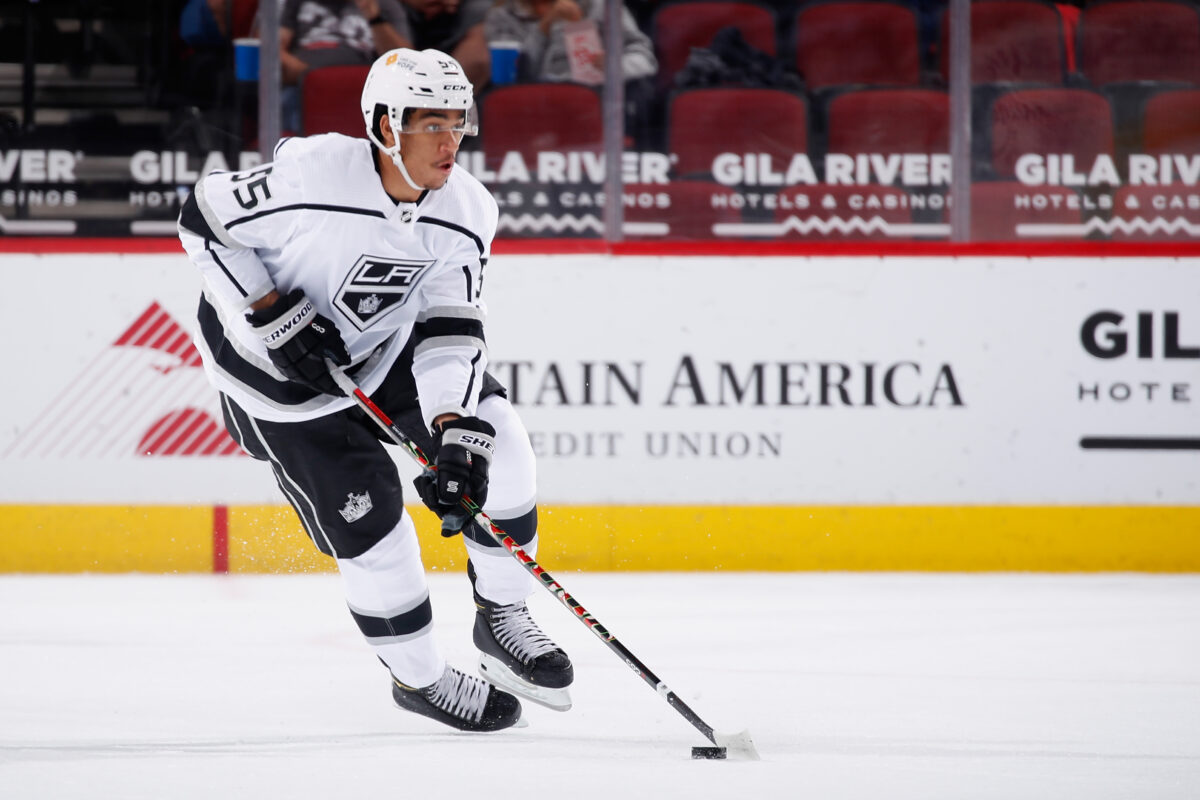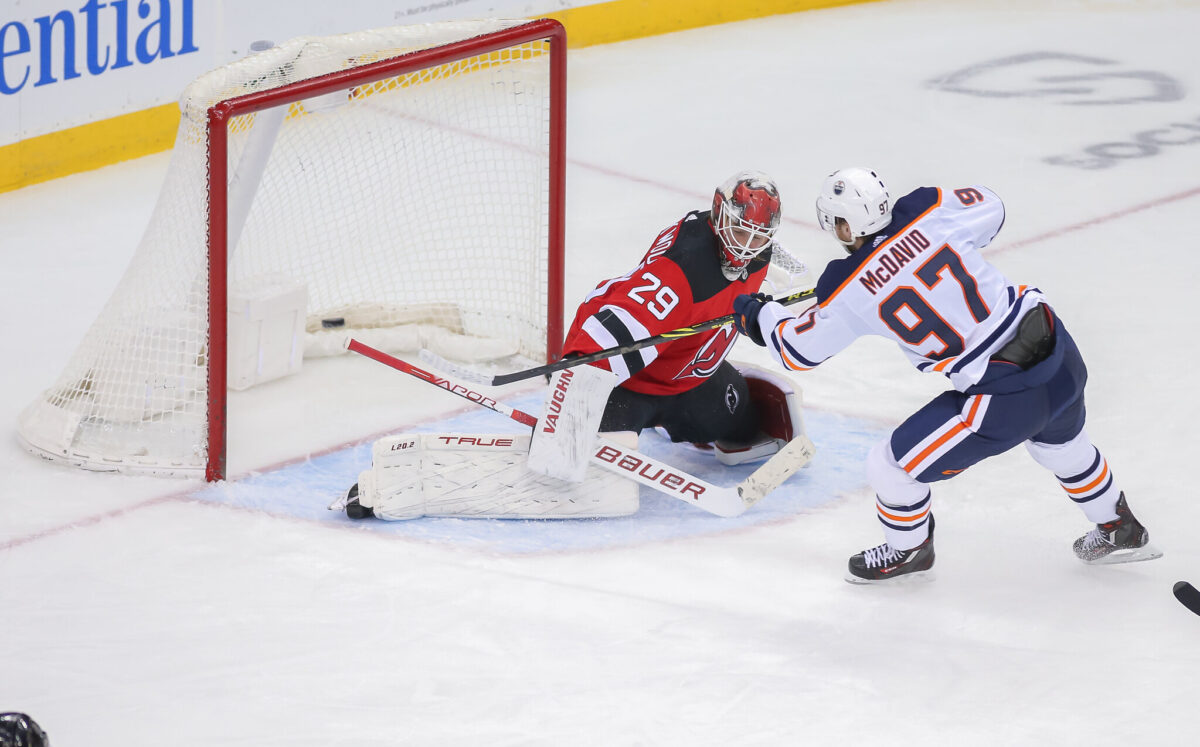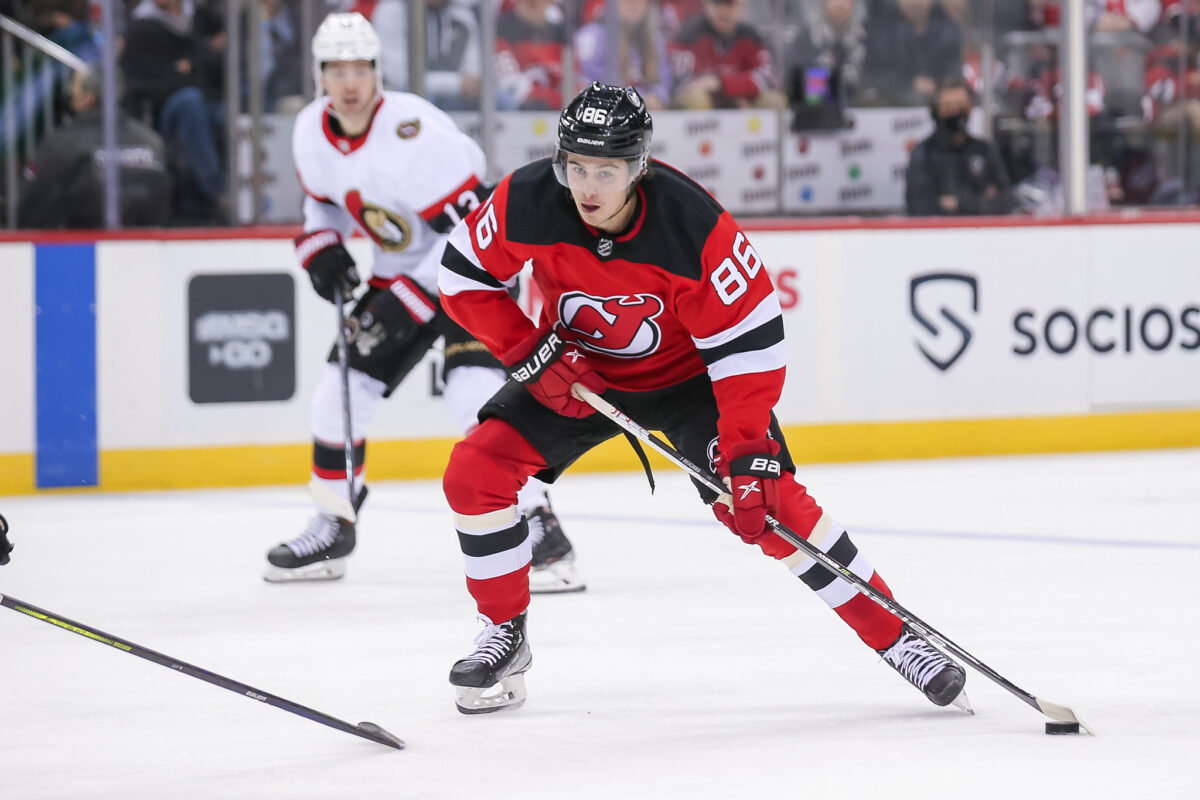The first half of the 2021-22 NHL season is almost in the books, and the league’s hierarchy appears fairly settled at this point in time. However, several teams have underperformed relative to expectations for various reasons, ranging from suspect goaltending to cold streaks of finishing luck. Yet, their strong underlying metrics suggest that the three following teams are primed for a significant reversal in results during the second half of the campaign – let’s dig in.
Boston Bruins
For a team used to presiding over the NHL’s Atlantic Division (finished either first or second four times since 2013-14), the Boston Bruins‘ start to the season leaves them in unfamiliar territory. Although their 24-12-2 record puts them on track for a 107-point season, they sit fourth in the Atlantic – just outside the divisional podium. The balance of power has shifted, with five of the top six and seven of the top 10 teams in the NHL this season by points percentage calling the Eastern Conference home.
Still, the Bruins are among the league’s most dominant teams in dictating play at 5v5, suggesting that they’ve been slightly unlucky in terms of actual results this season. Boston allows very few shots (first in shots against per-60-minutes) and scoring chances (second in SCA/60), resulting in a 57% share of expected goals (grades how likely a given shot is to become a goal based on historical evidence). They are the NHL’s best in this department, despite only accounting for 52% of actual goals on the year – 14th in the league by comparison.
A major factor in their scoring discrepancy is the relatively poor finishing of David Pastrnak, who still owns 19 goals on the season. Even while chugging along at a 41-goal pace, the 25-year-old winger is only scoring on 11.4% of his shots, 2.6 percentage points lower than his career average (14%). It appears as though the positive regression is already starting to kick in, as Pastrnak leads the NHL in goals (11) since January 1st. If the sniper continues on his familiar trajectory, the Bruins’ fortunes begin to look all that much brighter.
Apart from Pastrnak, Boston’s cast of depth scoring options find themselves in the same predicament of underperforming their expected goal count (expected goals minus actual goals). Their group of offseason additions in Erik Haula (-4.5 goals above expected) and Nick Foligno (-2.2), while Patrice Bergeron (-2.1) and Jake DeBrusk (-2.3) have also struggled to find the net at their usual rate. The team is collectively missing the mark, bringing down their entire offense.

It’s not as though their goaltending has been woeful either, with both Jeremy Swayman (.918 save percentage – SV%) and Linus Ullmark (.915) ranking within the top 22 of goaltenders (minimum five games played) according to SV%. Franchise icon Tuuka Rask has struggled since rejoining the team (.857 SV% in three games), but his game should recover as he reacclimates to NHL play after missing the first half of the season recovering from surgery.
Their efficiency on the power play (seventh) and penalty kill (eighth) puts them in the top 10 for special teams, complementing their even-strength dominance, and it’s only a matter of time until the standings match the underlying process. Watch out for the big bad Bruins in 2022, as the first half looks just to have been a minor stumbling block.
Los Angeles Kings
The first half of the season has been a welcome surprise for the Los Angeles Kings, as the team has nearly matched its 2020-21 point total (49 in 56 games) with 45 points in 41 games. The free-agent signing of defensive specialist Phillip Danault and the resurgence of championship holdovers in Anze Kopitar, Drew Doughty, and Jonathan Quick figure prominently in their prompt turnaround. As a result, Los Angeles is challenging for their first playoff berth since the 2017-18 season, kickstarting the next era of competitive Kings hockey.
Even with their improved results, the Kings have failed to convert on their robust play in 5v5 situations this season in a similar fashion to the Bruins. Per Natural Stat Trick, Los Angeles accounts for 54% of all shot attempts (CF%), 52.9% of scoring chances (SCF%), and 53.4% of expected goals (xGF%), all three of which are top eight ratios in the NHL. The Kings’ display at 5v5 is mostly driven by a strong rush offense (fourth in shots off of the rush per-60-minutes), ushering in a new brand for the franchise that is a far cry from their physical dominance of the early 2010s.
You May Also Like:
- Canadiens GM Hughes’ Top Priorities for 2024 Offseason
- Flyers 2023-24 Player Grades: Morgan Frost
- 10 Most Interesting Facts About the Pittsburgh Penguins
- The NHL’s Top-50 Russians of All-Time
- Every NHL Team’s Worst Contract
According to MoneyPuck, the Kings’ roster features four of the bottom 30 skaters by goals score above expected (GAx). The quartet of Trevor Moore (-7.4), Dustin Brown (-5.4), Viktor Arvidsson (-4.6), and Matt Roy (-3.8) is the most significant underperformers, and that poor finishing has summarily afflicted the rest of the lineup. Los Angeles’ power play grades out as top-half in terms of chance quality (11th in xGF/60) but 25th in actual efficiency, further emphasizing their cold streak and the need for another marksman via trade. Although it’s entirely possible that the team is chockful of below-average shooters, the extent of this slump suggests that their conversion should soon regress closer to expected.
The Kings’ goaltending is another bright spot this season, with both Quick and backup Cal Petersen bringing positive value in the crease. The veteran netminder ranks seventh in cumulative goals saved above expected (GSAx) according to MoneyPuck, and Petersen is about even with a 0.3 GSAx value. Los Angeles sits in the bottom half in terms of preventing shots and scoring chances, and their goaltending tandem has held firm through 41 games.
One developing storyline to watch in the second half is the return of prized prospect Quinton Byfield, the second-overall pick in the 2020 NHL Entry Draft. The 19-year-old center has found success in his pair of American Hockey League (AHL) stints, scoring 26 points in 43 games with the Ontario Reign over two seasons. Although it’s unfair to expect much of a teenager who has played in fewer than 10 total NHL games, slotting Byfield into a third-line role offers the Kings a uniquely gifted presence down the middle.

Although Los Angeles may remain a year or two away from truly disrupting the Western Conference hierarchy, the team is already a formidable 5v5 unit. I expect that they qualify for their first postseason of the decade this season. Still, Stanley Cup contention is on hold until their tantalizing crop of prospects develops with further professional ripening.
New Jersey Devils
Before I dive into the story of the New Jersey Devils this season, I should note that I am not declaring them a Stanley Cup contender, only that they should see an uptick in the win column in the near future. As of this writing, New Jersey is wedged in sixth in the unforgiving Metropolitan Division and sits 15 points behind the Bruins for the Eastern Conference’s second wildcard spot. Their playoff hopes are essentially extinguished, but that doesn’t mean that the Devils can’t witness marked improvement in the second half.
Despite being net-positive in terms of shots (50.8 SF% – 11th in the NHL) and scoring chances (51.7 SCF% – 10th), New Jersey has only delivered 44.6% of actual goals at 5v5, the sixth-worst mark in the league this season.
You don’t have to look far to find the main culprits, as the Devils’ team SV% of .888 ranks second-last in the NHL this season. Both Mackenzie Blackwood (-10.3 GSAx; .894 SV%) and Jonathan Bernier (-1.1; .902) have significantly underperformed relative to expectations, and their rotating cast of third-string options haven’t fared much better. When their two main goalies sit, their replacements collectively save .870 of all shots. At the NHL level, that’s simply not good enough.

It’s not as though the team is profusely bleeding chances either, as they rank 20th in SA/60 and sixth in high-danger attempts against per-60-minutes (HDCA/60) at 5v5. They may not be a defensive powerhouse, but they’re far from the worst group in the league.
Bernier is out for the rest of the season to recover from hip surgery, so all eyes are on Blackwood for the foreseeable future. His career .908 SV% indicates ample room for improvement, but his year-over-year decline in SV% represents a worrying trend. While growing pains are expected for the league’s youngest group (average age of 25.8), their netminders have undoubtedly sunk what is otherwise a solid unit.
Much of their inability to produce offensively can be traced back to the early absence of franchise star Jack Hughes, who has featured in only 22 of New Jersey’s 39 games to this point. It’s clear how impactful the third-year center is to the team’s fortunes, as his total of 22 points is still good enough for fourth in team scoring.

Further, Dougie Hamilton – the Devils’ big offseason splash – has missed nine games, forcing them to rely on the unexpected contributions of several young players. Jesper Bratt (34 points in 36 games) and rookie Dawson Mercer (22 in 39) are leading the way offensively, but New Jersey’s playoff aspirations have unsurprisingly spiraled due to their severely reduced depth.
With a fully healthy lineup and expected improvement from their usually competent goaltenders, the back-half of the season should be much more successful for the Devils. They follow a regimented game plan and boast a collection of young talent who should take the next step in their development in the near future. Can the Devils show that a playoff berth is in the cards in 2022-23?
Can These Teams Surprise the NHL in 2022?
In the grand scheme of things, 40-odd games in an 82-game season represent a limited, but not insignificant, sample of evidence for evaluating how teams stand at this point in the year. Teams who may otherwise be solid could experience a bout of finishing and/or goaltending misfortune, clouding their true strength. Luckily, the 2021-22 season runs for another few months, and it should become clear that these three teams are better than their results have suggested thus far in due course.
Data courtesy of All Three Zones, Hockey Reference, MoneyPuck, Natural Stat Trick, and the NHL. Statistics are accurate as of January 23.